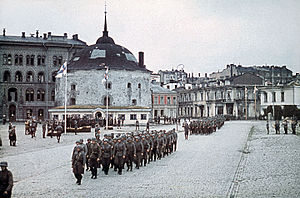Finnish reconquest of the Karelian Isthmus (1941)
| Reconquest of the Karelian Isthmus | |||||||
|---|---|---|---|---|---|---|---|
| Part of the Continuation War | |||||||
 Military parade in Viipuri on August 31, 1941, after its recapture. |
|||||||
|
|||||||
| Belligerents | |||||||
|
|
|
||||||
| Commanders and leaders | |||||||
|
|
|
||||||
| Strength | |||||||
| 3 Corps | 3 Corps | ||||||
The Finnish reconquest of the Karelian Isthmus (1941) refers to a military campaign carried out by Finland in 1941. It was part of what is commonly referred to as the Continuation War.
Early in the war Finnish forces liberated the Karelian Isthmus. It had been ceded to the Soviet Union on March 13, 1940, in the Moscow Peace Treaty, which marked the end of the Winter War.
Later, in the summer of 1944, the Soviet Union reconquered the southern part of the isthmus in the Vyborg-Petrozavodsk Offensive.
Between the Army of Karelia and Gulf of Finland there were three Finnish corps: II Corps (2.D, 15.D and 18.D) north of the Vuoksi River, V Corps (10.D) and IV Corps (4.D, 12.D and 8.D) defending the coast. On the Soviet side there were 19th Rifle Corps (142.D, 115.D), 50th Rifle Corps (43.D, 123.D), 10th Mechanised Corps (21.Armored D, 24.Arm. D. and 198.Mech. D) in reserve and the division-strength 22nd Karelian Fortified Region, which defended the coast. The Soviet X Mechanized Corps were transferred at the end of June from the Karelian Isthmus to the southwest of Leningrad to defend against advancing Germans but left 198.D as the only reserve to Soviet forces. The Finnish V Corps were disbanded and 10.D were attached first to IV Corps (Lt. Gen. Karl Lennart Oesch) and late July to II Corps (MJ.Gen. Taavetti Laatikainen) as a reserve. Both parties were first on the defensive, and only small, company or battalion size probing attacks were made by both sides to improve their own positions. The loss of reserves prompted the Soviets to retreat to more defensible lines at the northernmost part of the front and continued fortifying in depth, creating concrete and wooden strongpoints, digging trenches and laying minefields, although the Finns advanced to keep contact with the enemy. This situation continued until July 31, when the Finnish offensive began.
The Soviet fortification works had been concentrated near the river Vuoksi and along the roads, so the Finns concentrated their forces on narrow, deep breakthroughs over the roadless terrains which were supported by pioneers building temporary supply roads through the forests and over the swamps. The 18.D (Col. Pajari) attacked through the forest against the northernmost section of the Soviet 115.D and instead of following roads they secured a roadcrossing and advanced again over the forest to the next road where they did the same. The roadcrossings were occupied by stronger units, which had to defend against several armor supported Soviet counterattacks. During one of those counterattacks Private Vilho Rättö captured a Soviet AT gun and aiming through the barrel he managed to destroy four enemy tanks, earning him the first Mannerheim Cross granted to a private. Finally on August 4, the Finns managed to encircle and capture the Ilmee road crossing, thus forcing the Soviets to abandon their prepared positions between Ilmee and the border. The main thrust of 15.D (Col. Hersalo) was against the Soviet IR588/142.D, and concentrated the thrust against only a two kilometer wide section, where most of the artillery was concentrated. After breaching the border fortifications, they advanced five kilometers through the forest before coming to the road thus bypassing Soviet defences, which were encircled and captured one by one by forces coming behind the leading elements. After six days advance 15.D was only three kilometers from the Viipuri-Sortavala railroad and 15 km from the western corner of Lake Ladoga and close to encircling Soviet forces on its left side. The 2.D (Col. Blick) decided to encircle two battalions of Soviet IR461 which were defending Tyrjä village by encircling the village from east and pushing the defenders to Lake Tyrjänjärvi by using IR7/2.D while IR28/2.D passed the village and advanced southwards. While supported by artillery the Soviets managed to hold on four days, before the encirclement was complete. Some of the men were able to escape through the forests, but most of them and all their heavy equipment were trapped in the village. Also the Finns suffered heavy casualties in the fighting and the IR7 received the nickname Tyrjän rykmentti (Regiment of Tyrjä). The capture of Tyrjä opened a road towards the Elisenvaara railway crossing and on August 5 the first Finnish units reached the Viipuri-Sortavala railroad.
...
Wikipedia
